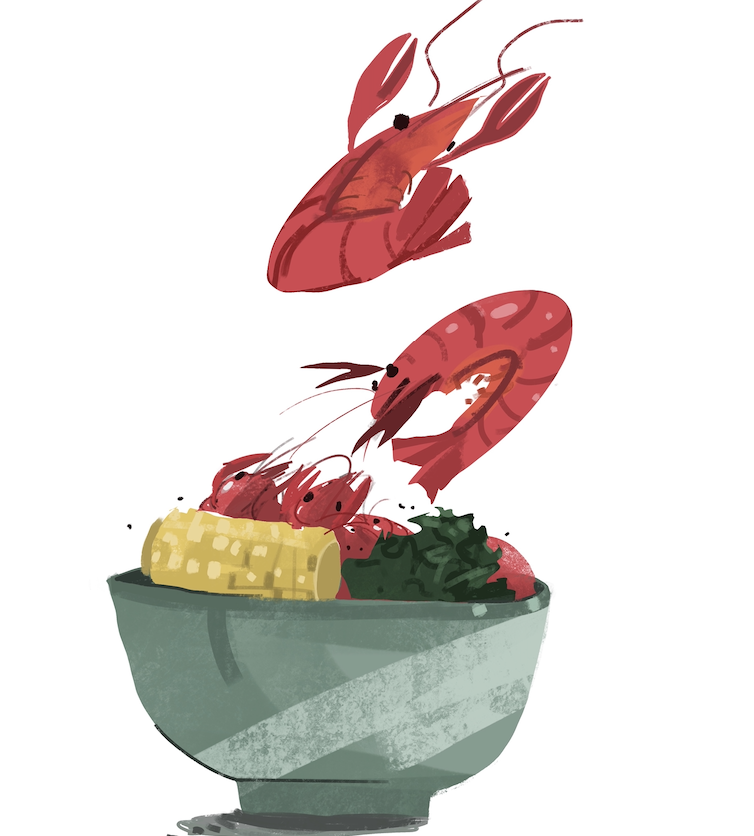Eating L.A. Before it Eats Itself: The Boiling Crab successfully melds cuisines

At the center of the food scene in Little Saigon — a community of Vietnamese residents and businesses spanning the cities of Westminster, Fountain Valley, Garden Grove and Santa Ana — seafood restaurants are pioneering an unexpected kind of fusion.
I stood outside a strip mall restaurant in the heart of Garden Grove, the smell of spices and butter seeping out of its doors. Even though my friends and I arrived 30 minutes before it even opened, we were in the back of a line 10 people thick. Our group of partially white, partially Asian, all high school juniors was waiting impatiently for The Boiling Crab.
The Boiling Crab serves Vietnamese-Cajun food, a twist on classic Cajun cooking with Vietnamese standards. Instead of a simple crawfish boil, seafood is cooked in broth full of staples like lemongrass, fish sauce and garlic. Within steaming bags of crawfish steeping in buttery, fragrant broth, is a story of American assimilation, Vietnamese identity and monetary success.
Vietnamese-Cajun food begins with the story of Vietnamese immigration in the United States. During the Fall of Saigon, thousands of Vietnamese refugees were relocated across America, filling military bases in California and Texas. These first wave immigrants gave others a bridge into a new world, and hundreds of thousands made the Gulf their home, settling in Louisiana, Florida and Texas, with a majority finding jobs in the seafood market.
In California, over 50,000 Vietnamese refugees were sent to Camp Pendleton after the Fall of Saigon, immediately placing a massive Vietnamese population near Orange County. With the allure employment opportunities and available land, North Orange County quickly became home to the largest Vietnamese population outside of Vietnam. It became a space safe for Vietnamese people to open restaurants, which over time became culinary destinations for outsiders and helped popularize dishes like pho and bánh mì.
While traditional Vietnamese food was popular within these communities, it did not take long for cooks to adopt the food that surrounded them, as they did centuries prior with French cuisine. With the large population of Vietnamese immigrants present in Louisiana, the Vietnamese style of preparing seafood and Cajun cuisines merged to become Viet-Cajun food.
Inside The Boiling Crab, my friends and I were greeted with signature covered walls and loud hip-hop music, something of a strip mall oddity. Larger paper tablecloths served as plates as we ordered round after round of seafood, all served in a plastic bag full of broth and spices. It’s an exciting and unusual restaurant experience, with little but a roll of paper towels to assist you with the meal, but it’s a memorable one, even four years later.
Eating Vietnamese crawfish is a messy process; there is no silverware, just an abundance of oil and spice. Regardless of the mess, Vietnamese-Cajun food became wildly popular in Houston and other Vietnamese communities during the late ‘90s because of both the familiarity of flavors and the novelty of the dish. A meal, a show and a bonding activity all on its own, the Vietnamese crawfish boil was an unstoppable force.
While Vietnamese-Cajun crawfish was developed in New Orleans, it became a business enterprise in Little Saigon, Orange County. The first Viet-Cajun restaurant to crop up in Orange County is a now-booming restaurant empire The Boiling Crab, owned by Houston transplant Dada Ngo. Prior to its two-year anniversary, Viet-Cajun crawfish had exploded onto the Little Saigon food scene. Restaurants like Rockin’ Crawfish, Cajun Islands, The Kickin’ Crab and countless others also foster crowds of devoted spicy seafood fans.
Those who flock to these restaurants trade concerns about authenticity and heritage for passion toward new and exciting tastes. Eating messy seafood out of the bag or off the tray with nothing but a bib and a roll of paper towels as a buffer is exciting, regardless of cultural background.
Vietnamese-Cajun food is a promising message that immigrants to the United States do not have to sacrifice their heritage to be successful, and that, in fact, unique cultural foods can be much more successful than monotonous American classics. Like tacos made with ground beef and cheddar cheese, Vietnamese immigrants recreated their seafood with the swamp crustaceans abundantly found in their new homes, creating a new style of food in the process.
These restaurants are both something familiar and something foreign. Families who grew up in Vietnam flock to these restaurants for the familiar flavors and the Vietnamese staff, while families who grew up in the U.S. are attracted to the novelty of a fusion food from seemingly disparate ends of the world. It isn’t an Americanized version of a motherland dish, like orange chicken or the hard-shell taco. Instead, Viet-Cajun food forges its own path through the culinary world, carving out spaces for other Asian-influenced cuisines to follow.
Christina Tiber is a junior writing about food. Her column, “Eating L.A. Before It Eats Itself,” runs every other Thursday.

